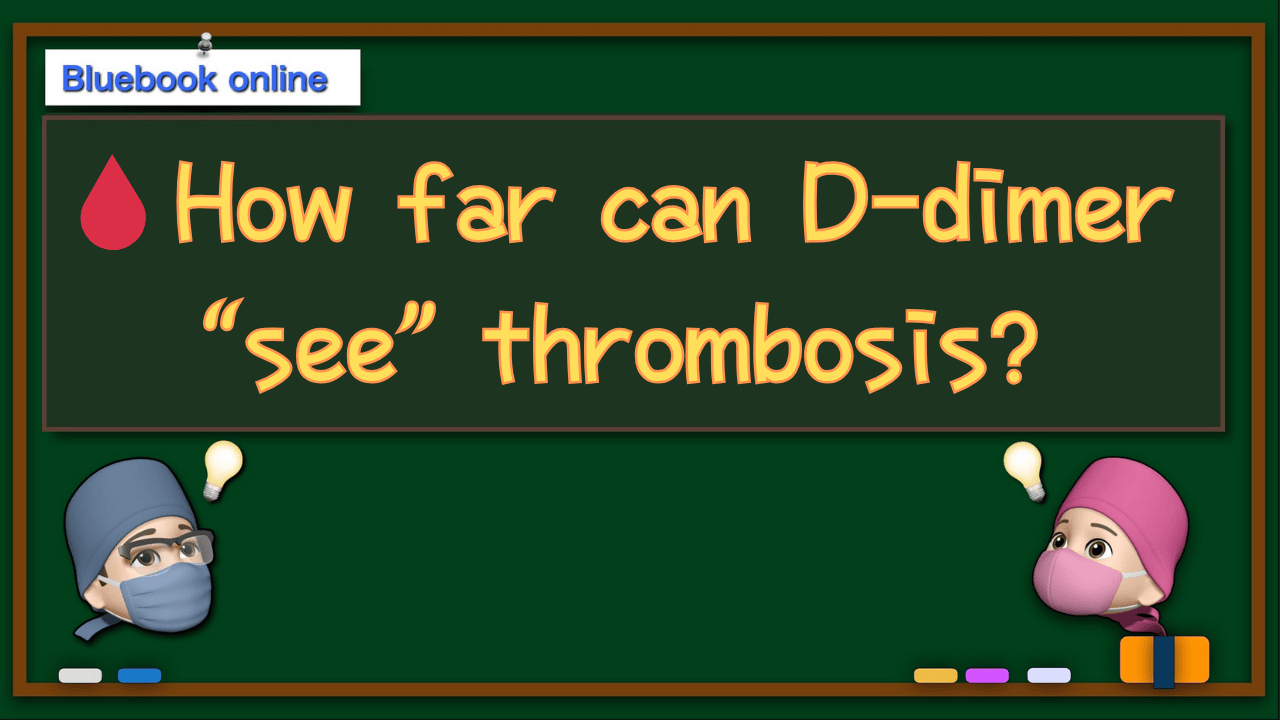👉👉 🇺🇸 All Posts 🇬🇧 / 🇯🇵 記事一覧 🇯🇵 👈👈
♦️ Introduction
 まっすー
まっすーPost-op D-dimer is high. Should I read this as ‘Thrombosis!’ every time?



I’ve heard ‘D-dimer negative = reassuring,’ but a positive isn’t always clot… right?



Let’s organize what D-dimer means, how it behaves around surgery, and how to use it for screening.


♦️ What is D-dimer?
D-dimer is a fibrin degradation product. When a clot forms (coagulation) and is later broken down by plasmin (fibrinolysis), the cross-linked D–D fragment remains.(👉 I shared a quick explanation on X.)
- It therefore reflects ongoing coagulation + fibrinolysis.
- Clinically it is highly sensitive and poorly specific: great to rule out VTE in low–intermediate probability, but not diagnostic when positive (post-op state, inflammation, older age, cancer, etc.).
♦️ Cutoffs, age adjustment, and units
D-dimer is present at low levels in everyone, so we need thresholds.
- Typical “negative” range: around 0.50 µg/mL (500 ng/mL); exceeding this is “elevated.”
- Older adults: baseline levels rise with age. Using an age-adjusted cutoff (≥50 yr: age × 10 ng/mL, FEU) reduces false positives (e.g., 70 yr → 700 ng/mL = 0.70 µg/mL).
- Units matter: labs report FEU or DDU. FEU values are about 2× DDU. Always check which unit your lab uses.
Pocket rule: “About 0.5; after 50, use age×10; check the unit.”
♦️ Why “high sensitivity, low specificity” matters
- Negative → reassuring (excellent NPV).
- Positive ≠ VTE (can be elevated after surgery, with inflammation, in malignancy, and in older age).
- Use clinical context and imaging when appropriate (leg ultrasound first-line; CTPA if PE suspected).
♦️ Perioperative reading—look at timing, not just the number
Around surgery, everyone’s D-dimer is “physiologically” up—so a single early high value ≠ clot.
Across multiple fields, post-op day 3 (POD3) repeatedly gives the best signal:
Several studies have reported that ⤵️
- Hepatobiliary–pancreatic (HBP) surgery:
- POD3 D-dimer best predicted DVT (AUC ≈ 0.76); POD3 was an independent predictor, and pre-op elevation predicted higher POD3.
- High-energy thoracolumbar trauma:
- POD3 correlated with thrombus dynamics (growth/unchanged/lysis); longer operations and more blood loss linked to thrombus growth.
- Brain tumor craniotomy:
- A simple POD3 D-dimer → if ≥ 2 mg/L then leg ultrasound flow increased detection of asymptomatic VTE; adding intra-op IPC reduced VTE.
Reading tip: track trends around surgery—POD3 is your anchor. Don’t decide on a single spike; combine trend + symptoms + risk + imaging.
♦️ A simple 3-step pathway when you suspect DVT
- Estimate pre-test probability (clinical likelihood):
Use the Wells score checklist to split into likely (≥ 2) vs unlikely (≤ 1). - Use D-dimer to filter:
- Unlikely: D-dimer first; negative rules out DVT.
- Likely: Ultrasound within ~4 h. If US negative, measure D-dimer; if positive, repeat US at 6–8 days. (Draw D-dimer before starting anticoagulation.)
- Confirm with imaging:
Leg ultrasound first; consider CTPA if PE is suspected (check renal function/contrast).
Smarter filtering (4D strategy): adjust the D-dimer cutoff by clinical probability
- Low risk (Wells unlikely): < 1000 ng/mL rules out
- Moderate risk: < 500 ng/mL rules out
This reduced ultrasound use by ~47% while keeping 3-month VTE ~0.6%—i.e., safe and efficient.
♦️ Periop “mini-algorithm” you can use tomorrow
- Check symptoms & risk: surgical magnitude, op time, blood loss/transfusion, SCI, cancer, prolonged bed rest.
- Clinical probability: Wells (2-level “likely / unlikely” is enough).
- D-dimer use
- Periop: read by trend; anchor at POD3 (esp. HBP).
- Older adults: apply age-adjusted cutoff (age×10 ng/mL, FEU).
- Low–moderate: consider probability-adjusted cutoffs (<1000 / <500 ng/mL).
- Imaging: US first. If initial US– but D-dimer+, repeat US in 6–8 days.
- Prevention: IPC and early mobilization reduce perioperative VTE (shown in neurosurgery cohorts).
Take-Home Points
- D-dimer = “clot made & broken” signal.
- Negative reassures; positive needs context (surgery, inflammation, aging, cancer can elevate).
- Cutoff ≈ 0.5; after 50 use age×10; check FEU vs DDU.
- In the OR world, timing > number—watch POD3.
- Diagnosis = Clinical probability → D-dimer → Ultrasound.
- Probability-adjusted cutoffs can safely reduce ultrasounds.
📚 References & Further reading
- NICE. Venous thromboembolic diseases: diagnosis, management and thrombophilia testing (NG158),Last updated 2023.
- Refer to this guideline for the diagnostic flow, use of D-dimer, and timing of repeat ultrasound examinations.
- Kearon C, et al. BMJ 2022;376:e067378.High preoperative D-dimer increases the risk of venous thromboembolism after gynecological tumor surgeries: a meta-analysis of cohort studies
- Using probability-adjusted D-dimer thresholds reduced the number of ultrasound examinations by approximately 47%, with only 0.6% adverse events within 3 months.
- Sakamoto T, et al. Surgery Today 2023.Evaluation of perioperative D-dimer concentration for predicting postoperative deep vein thrombosis following hepatobiliary-pancreatic surgery
- Postoperative day 3 (POD3) D-dimer was identified as an independent predictor of DVT (AUC 0.762).
- Zimmer K, et al. Acta Neurochir 2024.Influence of postoperative D-dimer evaluation and intraoperative use of intermittent pneumatic vein compression (IPC) on detection and development of perioperative venous thromboembolism in brain tumor surgery
- Implementation of POD3 D-dimer testing increased VTE detection, while intraoperative IPC reduced its incidence.
- Kumagai G, et al. J Spinal Cord Med 2020.D-dimer monitoring combined with ultrasonography improves screening for asymptomatic venous thromboembolism in acute spinal cord injury
- In patients with spinal cord injury (SCI), combining D-dimer monitoring with ultrasonography markedly improved the detection rate of asymptomatic venous thromboembolism (VTE) compared with either method alone.
- Li H, et al. Sci Reports 2025.Perioperative ultrasound screening of lower extremity veins is effective in the prevention of fatal pulmonary embolism in orthopedic patients
- Perioperative lower-extremity venous ultrasound screening was reported to be effective in preventing fatal pulmonary embolism among orthopedic inpatients, with additional discussion on cost-effectiveness.
- Meng Z, et al. Res Pract Thromb Haemost 2025.
- High preoperative D-dimer levels were associated with an increased risk of postoperative VTE in gynecologic oncology surgery (risk ratio 2.58 for dichotomized data, also rising as a continuous variable).
- StatPearls. D-Dimer Test(2025更新).
- Comprehensive review summarizing the high sensitivity but low specificity of D-dimer testing, age-adjusted cutoff strategies, and common causes of false-positive results.
🔗 Related articles
- to be added

コメントを投稿するにはログインしてください。